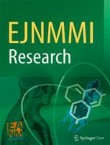- October 26, 2021
- Category: Nuclear Medicine, Scientific Publications

Lung Shunt Fraction Calculation using 99mTc-MAA SPECT/CT Imaging for 90Y Microsphere Selective Internal Radiation Therapy of Liver Tumors
Mike F. Georgiou1 , Russ A. Kuker1, Matthew T. Studenski2, Preeti P. Ahlman1, Megan Witte3 and Lorraine Portelance2
1 Department of Radiology, Miller School of Medicine, University of Miami, 1611 NW 12th Avenue, JMH C-248, Miami, FL 33136, USA.
2 Department of Radiation Oncology, Miller School of Medicine, University of Miami, Miami, FL, USA.
3 Department of Biomedical Engineering, University of Miami, Miami, FL, USA.
ABSTRACT
Background: 99mTc-macroaggregated albumin (99mTc-MAA) scintigraphy is utilized in treatment planning for Yttrium-90 (90Y) Selective Internal Radiation Therapy (SIRT) of liver tumors to evaluate hepatopulmonary shunting by calculating the lung shunt fraction (LSF). The purpose of this study was to evaluate if LSF calculation using SPECT/CT instead of planar gamma camera imaging is more accurate and if this can potentially lead to more effective treatment planning of hepatic lesions while avoiding excessive pulmonary irradiation.
Material and methods: LSF calculation was obtained using two different methodologies in 85 cases from consecutive patients intended to receive 90Y SIRT. The first method was based on planar gamma camera imaging in the anterior and posterior views with geometric mean calculation of the LSF from regions of interest of the liver and lungs. The second method was based on segmentation of the liver and lungs from SPECT/CT images of the thorax and abdomen.
Results: The differences in planar imaging versus SPECT/CT derived LSF values along with the estimated absorbed lung mean dose (LMD) were evaluated. The LSF values were higher in planar imaging versus SPECT/CT in 81/85 cases, with a mean value of 8.5% vs. 4.6% respectively; the difference was statistically significant using a paired t-test (alpha = 0.05). In those patients who received SIRT, the estimated absorbed LMD calculated with planar imaging was significantly higher than with SPECT/CT (t-test, P < 0.005). Repeated phantom experiments using an anthropomorphic torso phantom with variable 99mTc activity concentrations for the liver and lungs were performed with the standard patient protocol, demonstrated improved accuracy of the LSF calculation based on SPECT/CT than planar imaging (mean overestimated value of 6% vs. 26%).
Conclusion: This study demonstrates that LSF calculation using planar imaging can be significantly overestimated while calculation using SPECT/CT imaging and appropriate segmentation tools can be more accurate. Minimizing the errors in obtaining the LSF can lead to more effective 90Y SIRT treatment planning for hepatic tumors while ensuring the lung dose will not exceed the standard acceptable safety thresholds.
